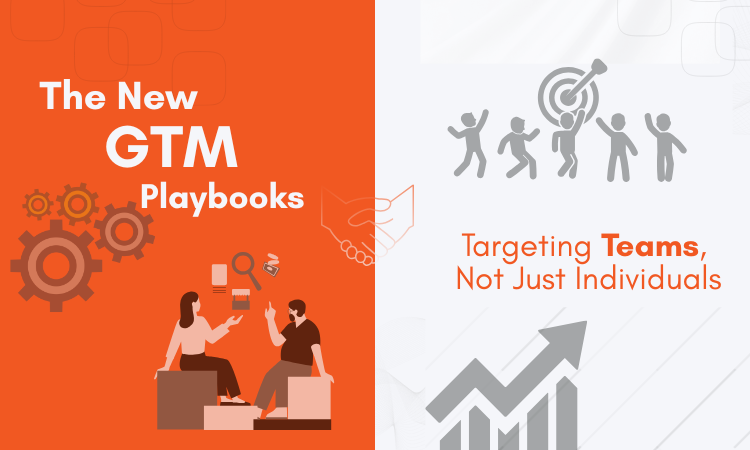- May 28, 2025
- Posted by: target
- Category: Blogs

The New GTM Playbook:
Targeting Teams, Not Just Individuals
In a rapidly changing environment and fast-paced markets, traditional approaches to Go-to-Market (GTM) can’t keep up with today’s team complexities. Marketers have long viewed individual buying decisions as the leverage point of their marketing strategies, but it seems time to change and shift focus to teams. Why? The individual decision-making of each member is different today, as no single individual is responsible for decisions; a single purchase decision is truly a team decision.
Gartner indicates that 75% of B2B buying decisions involve at least 6-10 decision makers. This shift is changing the approach organizations must take to their GTM strategy, and your approach must change to keep up.
Why Teams Matter More Than Ever
In the present ecosystems of B2B, it’s not just the CXOs or the Heads of Departments who make purchasing decisions; it is the entire buying committee (or the marketing, sales, finance, product, IT, and operations teams) that is responsible for agreeing on the value, as a collective, before any purchases are made. The teams have competing priorities based on what they care about the most: IT will want to know about integration and security, finance will want to learn about ROI, and operations will be more concerned with how fast they can implement it.
This change presents a new challenge: How can GTM teams successfully engage with multiple decision-makers with different priorities at the same time?
The Evolution of Decision-Making
Decision-making as a team requires a more integrated process. Organizations can no longer produce siloed, persona-based messages; instead, they must create comprehensive and connected narratives that will resonate with all members of the decision-making group. All members of the team will likely have their take on how a product or solution supports their function.
In one such case of a collaboration improvement product, the product appeals to the HR team from employee engagement perspectives, while the IT team will feel good about the security and scalability. The teams involved have different perspectives, such as:
- HR Team: Focus on employee engagement, morale, and culture. Their challenge is to build remote team cohesion and let tools help make their unique working styles productive.
- IT Team: Prioritizes security, scalability, and seamless integration with the systems. Their challenge is to allow the products on their platform to comply, protect sensitive data, and perform reliably under load.
- Marketing Team: Focuses on campaign performance, customer engagement, and lead generation. Their pain points need better personalization/engagement and proper analytical depth to analyze customer journeys and maximize ROI.
- Sales Teams: Prioritizes process alignment with lead management processes and/or sales enablement tools. Pain points include receiving high-quality, measurable leads and receiving real-time campaign insights to inform and tailor outreach efforts.
Only once each decision maker was able to understand the value and benefits of the product, a consensus was reached, and the deal was established.
So, How to Adapt Your GTM Strategy for Teams
- Understand Your Audience
Rather than focusing on individual personas, map out the full decision-making ecosystem. Create cross-functional buyer committee profiles that detail the pain points, priorities, and metrics of success for every department. - Create Collaborative Content
Create content that drives team alignment by replacing generic whitepapers with interactive ROI calculators, multi-perspective webinars, and success stories highlighting cross-functional value. - Use Multi-Touch, Multi-Channel Outreach
Single emails will not be enough. Create multi-touch engagement workflows that engage multiple decision makers with messages personalized for department-specific pain points and custom content shared over LinkedIn, email, or internal channels like the intranet. - Empower Internal Champions
Once a few key decision-makers are on board, empower them as internal champions to advocate for your solution. Equip them with co-branded decks, internal FAQs, and other materials that allow them to influence the rest of the team.
Outcomes: What You Gain by Targeting Teams
By shifting your focus from individual buyers to teams, organizations can expect:
- Shorter deal cycles, as alignment happens sooner in the process
- Higher win rates because of multi-decision-maker engagement
- Better product feedback leading to stronger product-market fit
- Stronger customer relationships, with more departments invested in success
Conclusion: The Future of GTM is Team-First
Team-based decision-making is not a passing trend. It is the new normal. If organizations are to be successful in today’s competitive landscape, they will need to shift their GTM strategies to recognize this reality. Organizations utilizing collaborative, role-aware, and multi-touch engagement strategies will offer differentiation in the market as it becomes more complex and crowded.
Targetorate supports organizations in transforming their GTM strategy to reflect today’s much more complex decision-making environment. Through our mix of robust buying intelligence, targeted content strategies, and data-driven execution, we help organizations turn multi-decision-maker complexity into a strategic advantage.
Let’s connect to discuss how we can support you in making your GTM strategy team first and future-ready.
